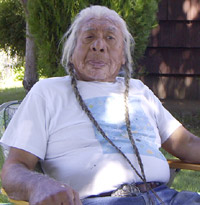Lewis & Clark Trail
Air Date: Week of September 5, 2003
This year marks the 200th anniversary of the Lewis & Clark expedition. Thousands of Americans are expected to visit historic points along the trail of discovery. Producer Barrett Golding cycled the entire trail and brings us this audio postcard of a tribal elder and spiritual leader in Lewiston, Idaho.
Transcript
CURWOOD: This year marks the 200th anniversary of the Lewis & Clark expeditions .
[WATER SPLASHES]
MAN: Paddle. Come on, harder.
CURWOOD: We wondered who lives and works along the trail now, from the northwest coast to the mouth of the Missouri.
WOMAN: One, Two, Three.
[MUSKET SHOT]
CURWOOD: Producer Barrett Golding bicycled the entire Lewis and Clark Trail and sent us a series of audio postcards like this one from his visit with tribal elder and spiritual leader Horace Axtell of the Nez Perce. in Lewiston, Idaho.
 Nez Perce Elder, Horace Axtell Nez Perce Elder, Horace Axtell |
AXTELL: Good morning – tats meywie, tats meywie (ph.). Daytime is tats hallop (ph.). It sounds really hard – hallop. And then evening or nighttime is koulawed (ph.), tats koulawed. Tats means good. Tats – everything is good. And when you say bad it’s topsice, topsice (ph.). Even the word sounds like it – bad (laughter). That’s the way the Nez Perce language is.
[BIRDS IN BACKGROUND] AXTELL: So, here I am. I’ve been the leader of our spirituality here for about 25 years or more. A lot of people will call it religion, but I term it as our way of life, because that’s the way our people lived a long time ago. And so we’re trying to keep it going. I do a lot of reburials and funerals and weddings and things like that that they have, the old Nez Perce way. Mostly the reburials, when people are resurfaced to the ground with erosion, construction. So I have to rebury the bones. So I’m well, I guess I’m really the only elder now that really can speak the language fluently. That’s because I grew up with my grandmother, and she never did learn how to read or write or speak English. So I teach my grandchildren and my relatives about all the ways that our people had, and try to speak the language, because that’s who we are. Our identity (speaking Nez Perce). How can I identify myself and this land where I live? It’s my homeland. To me, it’s like my sacred home. All the water that flows from different rivers and streams is like the blood veins we have in our bodies. Without blood veins we can’t live and without water we can’t live. People building homes along the river, and they’re polluting the river – I don’t know, some things I look at a different way. And they use all these chemicals to kill weeds, and all that in time comes into the rivers and water and into the earth, and then they dig wells on top of that (laughter). We’ve got two rivers, one here and one over there, and we have a water shortage (laughter). Unbelievable. So, I don’t know. It’s just the way I look at life. It’s just a battle all the way (Laughs). CURWOOD: Barrett Golding's portraits of the Lewis & Clark Trail: 200 Years Later are part of Hearing Voices, funded by the Corporation for Public Broadcasting. For more audio, images and interviews from the trail, please visit our website livingonearth.org.. [BIRDS CALLING, CRICKETS CHIRPING] CURWOOD: You’re listening to NPR’s Living on Earth. FEMALE ANNOUNCER: Funding for Living on Earth comes from the World Media Foundation. Major contributors include the William and Flora Hewlett Foundation, for coverage of western issues, and the Richard and Rhoda Goldman fund. Support also comes from NPR member stations and the Noyce Foundation, dedicated to improving math and science instruction from kindergarten through grade 12; and Bob Williams and Meg Caldwell, honoring NPR's coverage of environmental and natural resource issues, and in support of the NPR President's Council. Links
|





